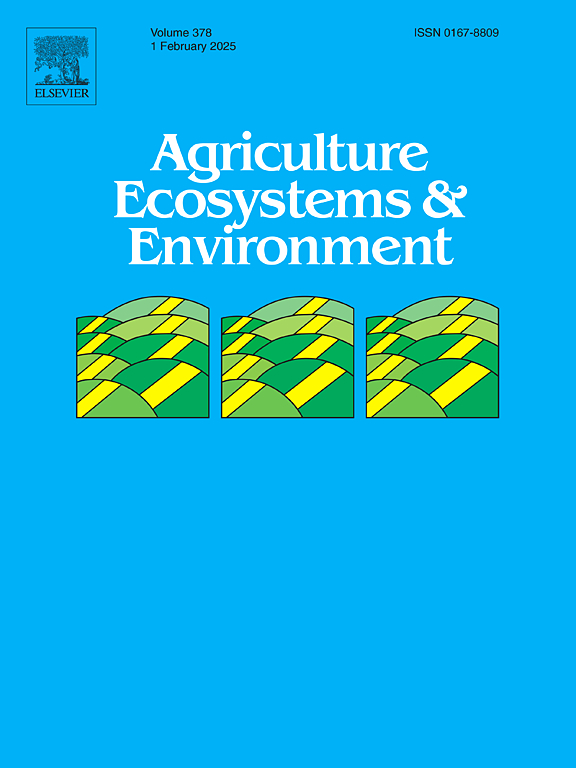水稻种植系统多样化的利益与权衡:对土壤健康、生产力和农业生态系统多功能的影响
IF 6
1区 农林科学
Q1 AGRICULTURE, MULTIDISCIPLINARY
引用次数: 0
摘要
多样化的作物轮作已被证明可提高土壤健康和产量,同时提供更广泛的生态系统服务,如增加生物多样性、水调节和温室气体缓解。很少有研究调查了传统上连续水稻(Oryza sativa L.)系统多样化的好处和权衡。同样,与调节、供应、支持和保护生态系统的综合供应有关的农业生态系统多功能性的影响仍不确定。我们的目标是在加利福尼亚州的46块土地上,就土壤健康、水稻产量、杂草丰度和除草剂投入等方面,与连续种植水稻相比,评估多样化作物轮作的综合表现。然后将结果组织到不同的ES类别中,以评估潜在的权衡和系统级多功能。在常规管理下,与连续稻田相比,多样化轮作使水稻产量提高13 %,杂草丰度降低。多样化降低了土壤有机碳(SOC)浓度、高锰酸盐可氧化碳(POXC)和柠檬酸盐可萃取蛋白(ACE),但增加了土壤微量元素(Mg、Mn、Fe和Zn)的有效性。土壤微生物生物量在不同轮作制度下相似,但不同轮作制度下微生物群落的丰度与矿化过程有关。在ES分类中,在常规管理下,不同轮作方式的水稻田系统在调节和保护生态系统服务(降低有机碳浓度和微生物能量源保留、降低氮(N)保留和减少鸟类栖息地)方面表现出显著的权衡,而在有机管理下,不同轮作方式的水稻田系统在调节和保护生态系统服务(N保留、微生物能量源保留、微生物能量源保留)方面表现出更平衡的调节和支持服务。矿化和养分利用率)。由于每个系统内的ES权衡,没有观察到农业生态系统多功能性的差异。结果表明,在水淹水稻系统中,多样化的作物轮作有多种好处,这可能直接或间接地支持农民的目标,如养分可用性、杂草控制和产量,但需要更多的研究来了解在景观尺度上确定的权衡,并在所有ES类别中实现效益最大化。本文章由计算机程序翻译,如有差异,请以英文原文为准。
Benefits and tradeoffs of diversifying rice-based cropping systems: Impacts on soil health, productivity, and agroecosystem multifunctionality
Diversified crop rotations have been shown to increase soil health and yields while providing broader ecosystem services (ES), such as increasing biodiversity, water regulation and greenhouse gas mitigation. Little research has investigated the benefits and tradeoffs of diversification in what traditionally have been continuous rice (Oryza sativa L.) systems. Likewise, impacts on agroecosystem multifunctionality, relating to the combined supply of Regulating, Provisioning, Supporting, and Conserving ES, remain uncertain. Our objective was to evaluate the integrated performance of diversified crop rotations compared to continuous rice on 46 fields in terms of soil health, rice grain-yield, weed abundance, and herbicide inputs in California. Results were then organized into different ES categories to assess potential tradeoffs and systems-level multifunctionality. Under conventional management, diversified rotations led to 13 % higher rice yields and lower weed abundance than continuous rice fields. Diversification reduced soil organic carbon (SOC) concentrations, permanganate oxidizable carbon (POXC), and autoclave citrate extractable (ACE) protein, but increased soil minor element availability (Mg, Mn, Fe, and Zn). While soil microbial biomass was similar among cropping systems, microbial communities under diversified rotations trended towards higher bacterial abundance associated with mineralization processes. When translated into ES categories, under conventional management, diversified rotations in flooded rice systems presented notable tradeoffs for several Regulating and Conserving ecosystem services (lower SOC concentrations and microbial energy source retention, lower nitrogen (N) retention, and reduced bird habitat), whereas diversified rotations under organic management presented more balanced Regulating and Supporting services (N retention, microbial energy source retention, mineralization and nutrient availability). As a result of ES tradeoffs within each system, no differences in agroecosystem multifunctionality were observed. Results suggest multiple benefits for diversified crop rotations in flooded rice systems, which may directly or indirectly support farmer goals such as nutrient availability, weed control and yields, but more research is needed to understand the identified tradeoffs at the landscape scale and maximize benefits across all ES categories.
求助全文
通过发布文献求助,成功后即可免费获取论文全文。
去求助
来源期刊

Agriculture, Ecosystems & Environment
环境科学-环境科学
CiteScore
11.70
自引率
9.10%
发文量
392
审稿时长
26 days
期刊介绍:
Agriculture, Ecosystems and Environment publishes scientific articles dealing with the interface between agroecosystems and the natural environment, specifically how agriculture influences the environment and how changes in that environment impact agroecosystems. Preference is given to papers from experimental and observational research at the field, system or landscape level, from studies that enhance our understanding of processes using data-based biophysical modelling, and papers that bridge scientific disciplines and integrate knowledge. All papers should be placed in an international or wide comparative context.
 求助内容:
求助内容: 应助结果提醒方式:
应助结果提醒方式:


